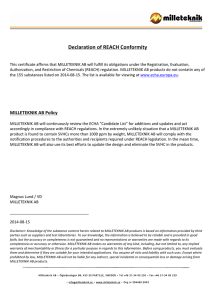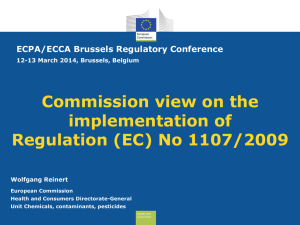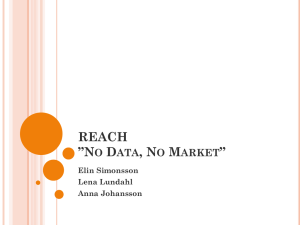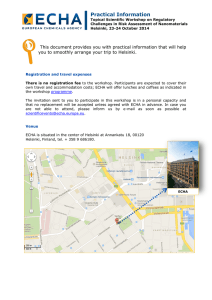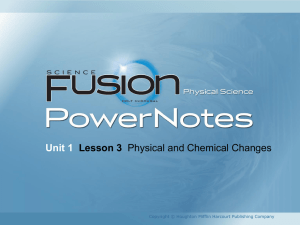Authorisation
advertisement
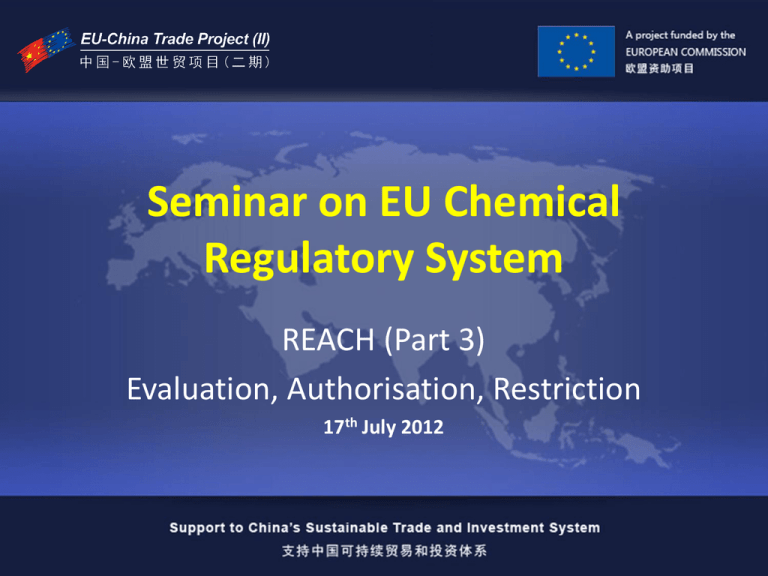
Seminar on EU Chemical Regulatory System REACH (Part 3) Evaluation, Authorisation, Restriction 17th July 2012 欧盟化学制品监管体系 专题研讨会 REACH (第三部分) 评估、授权、限制 2012年7月17日 Evaluation under REACH • Evaluation focuses on three evaluation processes. 1. the examination of testing proposals; 2. the compliance check of registrations; 3. the substance evaluation. 根据REACH进行评估 • 评估主要关注三个评估流程 1. 试验计划检查; 2. 注册合规检查; 3. 物质评估。 Examination of testing proposals • Registrants submit Testing Proposals to ECHA to undertake 'higher-tier' tests required by REACH at tonnages of 100 or more per annum as listed in Annexes IX and X if they identify a data gap and cannot otherwise fulfil the REACH information requirements • Evaluates the adequacy and relevance of testing proposals submitted in the registration dossier by the registrant in case further testing is necessary for information specified in Annexes IX and X of the REACH Regulation. 试验计划检查 • 按照REACH要求,按附录IX和X所列,对年吨位等于或 超过100吨的物质,如果注册人发现数据缺口且无法 通过其它途径满足REACH的信息要求,注册人需向 ECHA提交试验计划,进行“高级试验”。 • 需对注册人提交的试验计划的充分性和相关性进行评 估,以防为满足REACH附录IX和X要求的信息需要进行 进一步的试验。 Examination of testing proposals • Examines also the necessity of any proposed tests involving vertebrate animals, taking into account the scientifically valid information provided by third parties during the consultation. 试验计划检查 • 还需检查所有脊椎动物试验的必要性,考虑到在咨询 过程中由第三方提供的科学可信的信息。 Examination of testing proposals • Examination of a testing proposal always results in a draft decision. – Testing proposals - submission of information by third parties. 试验报告检查 • 试验报告检查的结果为决议草案。 – 试验报告-由第三方提交的信息 Examination of testing proposals – Submission of relevant information. (45 days). – Evaluation of submitted information • Current consultations – http://echa.europa.eu/information-onchemicals/testing-proposals 试验计划检查 – 相关信息的提交 (45 天) – 提交信息的评估 • 现有咨询网站 – http://echa.europa.eu/information-onchemicals/testing-proposals Examination of testing proposals Draft decision: •a decision accepting the testing proposal; •a decision accepting the testing proposal with modifications of the testing conditions; •a decision accepting or rejecting the testing proposal but requiring one or more additional tests; •a decision rejecting the testing proposal, or •a decision covering any of the three first options (several proposals are submitted for the same substance and the same tests) 试验报告检查 决议草案: •批准试验报告的决议 •批准试验报告的决议,但是需对试验条件进行修改 •批准或拒绝试验计划的决议,但要求进行一次或更多 次附加试验 •拒绝试验计划的决议,或 •包含以上三种选择的决议(同一物质和同一试验提交 了几个计划) Compliance check of registrations • Registration – ECHA checks each submitted dossier during the technical completeness check (TCC) to confirm that the necessary information has been provided and the appropriate fee has been paid before it issues a registration number. • ECHA may examine any registration dossier to verify if the information submitted by registrants is in compliance with the legal requirements. • ECHA must check at least 5% of the registration dossiers of each tonnage band. 注册合规检查 • 注册 – 在技术完整性检查(TCC)过程中, ECHA对每一份 提交的档案进行检查,确认档案包含所有必要信息 且相关费用已经支付之后,再颁发注册号。 • ECHA 可以对任意注册档案进行检查,确认注册人提 交的信息符合法律要求。 • ECHA 必须对每个吨位范围的注册档案的5%进行检查 Compliance check of registrations • A compliance check can start at any time in respect of any dossier. • Three possible results: – No action towards the registrant. – Quality observation letter (and invite the registrant to update the dossier or to clarify certain aspects of the dossier). – Draft and final decisions. Decisions to request additional information (ECHA may conclude that additional testing is required). 注册合规检查 • 任何档案的合规检查都可随时开始 • 三种可能的结果: – 对注册人不采取任何措施 – 质量观察信(并邀请注册人更新档案或对档案的某 些方面进行澄清) – 决议草案和最终决议 要求附加信息的决议(ECHA 可做出必须进行附加试验的决定) Compliance check of registrations • Once ECHA has issued the draft decision to the registrant, the registrant has 30 days to provide comments and update the dossier. • The deadline and the way for providing the comments are specified in the notification letter to the draft decision. • The registrant may also during this time update the dossier with information relevant for the data gaps addressed in the draft decision (e.g. an improved justification for using adaptations to standard information requirements). 注册合规检查 • 一旦ECHA向注册人颁发决议草案,注册人有30天时 间提供评论和更新档案。 • 提供评论的截止日期和方式在决议草案的通告信函里 有说明。 • 注册人也可以在此期间更新档案,添加在决议草案中 指出的与信息缺口相关的信息(如对标准信息要求进 行修改所需的更为充分的理由)。 Compliance check of registrations • If, after reviewing the registrant's comments and/or updated dossier, ECHA now considers the dossier to be compliant, the decision process is terminated and the examination closed with no further administrative action. • If not, ECHA will send information to Member States Competent Authorities (MSCA) for their review. • After receiving ECHA's draft decision and the comments of the registrant, the MSCA has 30 days to comment on or propose amendments to the draft decision. • All evaluation decisions made by ECHA must be unanimously supported by EU Member States. If unanimous agreement cannot be reached, the European Commission will decide. 注册合规检查 • 如果在对注册人的评论和/或更新档案进行审核后,ECHA现认 为档案合规,则决议流程终止,不再采取进一步行政措施,检 查关闭。 • 如果审核不合规,ECHA会将相关信息发往成员国主管当局 (MSCA),由其进行审核。 • 在收到ECHA的决议草案和注册人的评论后,MSCA有30天时间 对决议草案发表评论或提出修改意见。 • 所有由ECHA做出的评估决议必须由EU成员国全体通过。如果 无法达成统一意见,则由欧盟委员会作出决定。 Substance evaluation • Member States evaluate certain substances to clarify whether their use poses a risk to human health or the environment. • The Competent Authorities of the Member States can propose substances for substance evaluation. • The objective is to request further information from the registrants of the substance to verify the suspected concern, if necessary. • The selected substances are listed by ECHA in the Community Rolling Action Plan (CoRAP) 物质评估 • 成员国对某些物质进行评估,确认其使用是否会对人 体健康和环境造成危害。 • 成员国主管当局可就需进行评估的物质提出建议。 • 目的即在必要的情况下,向该物质注册人索取更多信 息。 • 被选中需进行评估的物质将由ECHA列入欧共体滚动行 动计划 (CoRAP)。 Substance evaluation • Selection criteria to prioritise substances for Substance Evaluation. • Article 44(1) reads: 1. “(...) The criteria shall consider: 2. (a) hazard information, for instance structural similarity of the substance with known substances of concern or with substances which are persistent and liable to bio-accumulate, suggesting that the substance or one or more of its transformation products has properties of concern or is persistent and liable to bio-accumulate; 3. (b) exposure information; 4. (c) tonnage, including aggregated tonnage from the registrations submitted by several registrants.” 物质评估 • 进行物质评估的物质排序的选择标准 • 第44条(1) 提到: 1. “(...) 标准需考虑下列因素: 2. (a) 危害相关信息,例:某物质与已知关注物质或易产生或可 能产生生物累积的物质之间的结构相似。这表示该物质或其一 个或以上的转化产物也为关注物质且易产生或可能产生生物累 积; 3. (b) 物质接触相关信息; 4. (c) 吨位,包括由几个注册人提交的注册吨位的累加吨位” Substance evaluation • The first CoRAP lists 90 substances for evaluation. • The substances are distributed for evaluation in the years 2012, 2013 and 2014. • Thirty-six substances are being evaluated in 2012. http://echa.europa.eu/documents/10162/13628/corap_2012_en.pdf 物质评估 • 最初的CoRAP 列出了90种需进行评估的物质 • 这些物质将在2012, 2013 和 2014年进行评估 • 2012年正在进行评估的有36种物质。 http://echa.europa.eu/documents/10162/13628/corap_2012_en.pdf Substance evaluation • The evaluation may lead to measures such as: • A proposal for harmonised classification and labelling for carcinogenic, mutagenic or toxic to reproductions, respiratory sensitisers or other effects. • A proposal to identify the substance as a substance of very high concern (SVHC). • A proposal to restrict the substance. • Actions outside the scope of REACH such as a proposal for EU-wide occupational exposure limits, national measures or voluntary industry actions 物质评估 • 评估完成后采取的相应措施可能是: • 建议进行调和分类,标识为对生殖产生致癌、诱变或 毒性作用、导致呼吸道过敏或产生其它影响。 • 将物质标识为高度关注物质(SVHC)。 • 建议对该物质进行限制。 • 采取REACH范围以外的措施,如建议设立EU范围内的 职业接触限值、采取国家性措施或自愿的行业性措施 。 Evaluation Report 2011 • Companies, which have to register substances by the next REACH deadline of 31 May 2013, are strongly advised to use the recommendations from the 2011 Evaluation report to ensure that their dossiers are compliant. • The Agency checked the compliance of 239 dossiers and examined 216 testing proposals. • http://echa.europa.eu/documents/10162/13628/evaluat ion_report_en.pdf 2011评估报告 • 强烈建议下个物质注册截止日期为2013年5月31日的 公司采纳2011评估报告给出的建议来确保其档案合规 • 欧洲化学品管理局已对239份档案和216份试验报告是 否合规进行了检查。 • http://echa.europa.eu/documents/10162/13628/evaluat ion_report_en.pdf Authorisation • The authorisation procedure aims to assure that the risks from Substances of Very High Concern are properly controlled and that these substances are progressively replaced by suitable alternatives while ensuring the good functioning of the EU internal market. • The placing on the market and use of Substances of Very High Concern included in the Authorisation List requires an authorisation 授权 • 物质授权程序致力于保证高度关注物质所导致的危险 得到合理控制,且在确保EU内部市场良好运转的情况 下,逐渐用合适的替代品代替这些物质的使用。 • 授权清单中包含的高度关注物质的市场投放和使用需 要进行授权。 Authorisation Substances of Very High Concern (SVHCs) • Substances meeting the criteria for classification as carcinogenic, mutagenic or toxic for reproduction category 1A or 1B in accordance with Commission Regulation (EC) No 1272/2008 (CMR substances) • Substances which are persistent, bioaccumulative and toxic (PBT) or very persistent and very bioaccumulative (vPvB) according to REACH (Annex XIII) • Substances identified on a case-by-case basis, for which there is scientific evidence of probable serious effects that cause an equivalent level of concern as with CMR or PBT/vPvB substances ery High Concern (SVHCs) 授权 高度关注物质 (SVHCs) •根据欧委会法规(EC) 号 1272/2008 (CMR 物质),符合1A 或1B类型的对生殖产生致癌、诱变或毒性作用的物质分 类标准的物质 •被REACH(附录XIII)定义为难降解、具有生物聚集性 和毒性(PBT) ,或很难降解且生物聚集性强(vPvB)的物质 。 •需逐个进行标识的物质,且有科学证据标明该物质可 能导致严重影响,从而使该物质受到与CMR 或 PBT/vPvB 物质相同的关注度。 ery High Concern (SVHCs) Authorisation The Candidate List •A Member State or ECHA at the request of the European Commission, can propose a substance to be identified as a Substance of Very High Concern (SVHC). •If identified, the substance is added to the Candidate List, which includes candidate substances for possible inclusion in the Authorisation List (Annex XIV). •The inclusion of a substance in the Candidate List creates legal obligations to companies manufacturing, importing or using such substances, whether on their own, in preparations or in articles. 授权 候选名单 •在欧盟委员会的请求下,成员国或ECHA建议将某种物 质标识为高度关注物质(SVHC) 。 •如果被标识为SVHC,该物质将被列入候选名单。候选 名单包括可能列入授权清单(附录XIV)的候选物质。 •若某物质被列入候选名单,制造、进口或使用该物质 本身、配置中的该物质或物品中的该物质的公司将产生 法律义务。 Authorisation The Candidate List • The intention to propose a substance to be identified as an SVHC is made public before the proposal is submitted so as to give advanced information to industry and other stakeholders. • The proposal is prepared according to Annex XV of REACH. Two main parts: – First one provides the data and justification for identifying the substance as an SVHC– Second part, includes information on volumes on the EU market and the uses of the substance, the resulting release and exposure, and possible alternatives to the substance. 授权 候选名单 •将物质标识为SVHC的建议意图应在在建议提交前进行 公布,以便向行业和其它利益相关者预先提供信息。 •建议根据REACH附录XV制定,主要包含两个部分: – 第一部分提供将该物质标识为SVHC的相关数据和理由 – 第二部分包括物质在EU市场的流通量、物质使用、使用产 生的释放和接触以及可能的该物质的替代品信息 Authorisation The Candidate List •After publication of the proposal anyone can comment on it or add further information. •If no comments are received, the substance is included in the Candidate List. •The proposals and the comments will be forwarded to the Member State Committee (MSC) to agree on the identification as an SVHC. •If the committee does not reach a unanimous agreement, the matter will be referred to the European Commission. 授权 候选名单 •在建议发布后,任何人都可对其进行评论或添加更多 信息。 •如果没有评论,物质即被列入候选名单。 •建议和评论将被发往成员国委员会 (MSC),获得对将该 物质标识为SVHC的认。 •如果委员会没有达成一致意见,将交由欧盟委员会做 决议。 Authorisation • The Candidate List is regularly updated when more substances are identified as SVHC. • On the website of ECHA a registry of intentions is published. One of the aims of this registry is to allow interested parties to be aware of substances which might be identified as SVHC before they are included in the Candidate List. 授权 • 当更多物质被标识为SVHC时,候选名单将会定期进行 更新。 • 在ECHA的网站上存在意图注册这一项注册。这一注册 的目的是允许利益相关方在物质被列入候选名单前, 了解这些有可能被标识为SVHC的物质。 Substances in Articles Notification of substances in articles is required of producers and importers of articles when all conditions of Article 7(2) are met: • The substance is included in the Candidate List for authorisation. • The substance is present in articles produced and/or imported above a concentration of 0.1% (w/w). • The total amount of the substance present in all articles produced and/or imported, whichcontain more than 0.1% (w/w) of the substance, exceeds 1 tonne per actor per year. The obligation to notify substances in articles also applies to packaging materials. Notification shall be made at the latest 6 months after it has been included on the Candidate List 物品中的物质 当满足第7条(2) 的所有条件时,物品的生产商和进口商 需对物质进行通报: •物质被列入授权候选名单。 •物质在生产和/或进口的物品中的含量超过 0.1% (w/w)。 •在所有生产和/或进口的物品(物品中该物质含量大于0.1% (w/w) )中物质的总数量超过每年1吨。 物品中物质的通告义务也适用于包装材料。 最迟须在物质被列入候选名单后的6个月内完成通报。 Substances in Articles Information to be notified to ECHA – the identity and contact details of the producer or importer of the articles – the registration number for the substance, if available – the identity of the SVHC – the classification of the substance – a brief description of the use(s) of the substance in the article(s) as specified in section 3.5 of Annex VI and of the uses of the article(s) – the tonnage range of the substance contained in the articles, i.e. 1-10 tonnes, 10-100 tonnes, 100-1000 tonnes or ≥1000 tonnes 物品中的物质 向ECHA通报的信息 – 物品生产商或进口商身份和联系方式 – 物质的注册号(如果有) – SVHC的标识 – 物质的分类 – 根据附录VI 3.5节中规定,对物质的用途、物品的 用途和物品中物质含量的吨位范围(如1-10 吨, 10100 吨, 100-1000 吨 或 ≥1000 吨 )做简单介绍。 Substances in Articles Obligations according to Article 33 •The aim of Article 33 is to ensure that sufficient information is communicated down the supply chain to allow the safe use of articles. •A supplier of articles containing a SVHC included on the Candidate List for authorisation in a concentration above 0.1% (w/w) has to provide relevant safety information about this substance available to him to the recipients of these articles. •“recipients” refers to industrial or professional users and distributors, but not to consumers 物品中的物质 第33条规定的义务 •第33条的目的是确保供应链上充分信息的传达,以保 证物品的安全使用。 •列入授权候选名单的某种SVHCA在物品中的含量超过 0.1% (w/w)的物品供应商必须向该物品的接收人提供可 得的物质相关信息。 •“接收人” 指的是工业或职业使用者,而不是消费者。 Substances in Articles Obligations according to Article 33 • In order for an article supplier to determine what information he shall communicate according to Article 33, he has to consider: – what the downstream life-cycle stages of the article are up to final disposal (transport, storage, uses) – what the potential routes of exposure are during each of these life-cycle stages – what the hazards of the SVHC are for human health and the environment – what types of exposure control / personal protection measures are likely to be appropriate during each of the life-cycle stages in order for the handling of the article to be considered safe. 物品中的物质 第33条所规定的义务: •为了决定哪些是按照第33条需传达的信息内容,供应 商必须考虑: – 物品在最终弃置之前会经历哪些下游生命周期阶段 (运输、 存储、使用) – 物品在各个生命周期阶段可能出现的接触方式 – SVHC带来的哪些危害是针对人体健康和环境有害的 – 在各个生命周期阶段,为了安全处置物品,需要采取哪些 类型的接触控制/人员防护措施 Authorisation 授权 Authorisation Applications for authorisation • Manufacturers, importers or downstream users can apply for an authorisation for the placing on the market or the use of a substance on the Authorisation List. • The applicant can demonstrate that the risk from the use of the substance is adequately controlled. • If not, the applicant must prove that the socio-economic benefits of using the substance outweigh the risks and there are no suitable alternative substances or technologies. 授权 授权申请 •制造商、进口商或下游用户可以申请对列入授权清单 的物质的市场投放和使用进行授权。 •申请者需证明物质使用产生的危险得到了充分控制。 •如果不能证明,申请者必须证明使用该物质带来的社 会经济益处大于其带来的危害,且还不存在合适的替代 品或技术。 Authorisation Applications for authorisation • Notification of intention to submit an Application for authorisation and Request form for a Pre-submission information session with ECHA. – Future applicants for authorisation may request a presubmission information session with ECHA to clarify regulatory and procedural issues related to the authorisation application process 授权 授权申请 • 提交授权申请和与ECHA进行提交前信息会话的申请书 – 将来的授权申请者可向ECHA申请进行提交前的信 息会话,以确认与授权申请程序相关的监管和程序 问题。 Authorisation Applications for authorisation •Submission of the application and fee payment. – You can prepare and Submit an Application for Authorisation using IUCLID 5. • Chemical safety report. • Analysis of the possible alternatives. • Plan to substitute the substance, if it’s possible. • Socio-economic analysis – To better plan the committees' workload, ECHA establishes specific periods for submitting applications for authorisation. •Checking of application's conformity. (Article 62) 授权 授权申请 •免费申请提交 – 可使用IUCLID5制备和提交授权申请 • 化学安全报告 • 可能替代品的分析 • 替代该物质的计划(如果可能) • 社会经济分析 – 为了更好的规划委员会的工作量,ECHA设立了提交授权申 请的特定时段。 •申请合规检查 (第62条) Authorisation • Applications for authorisation – Public consultation on the uses applied for. – Draft opinions by RAC and SEAC (Within 10 months) – Comments on the draft opinions, two months before the Committee adopt their final opinions – Adoption of final opinions by RAC and SEAC – EU Decision – Downstream users of an authorised substance must also comply with the decision and notify to ECHA the use of the substance within three months of the first supply of the substance. – Review. Holders of authorisations must submit a review report at least 18 months before this review period ends 授权 • 授权申请 – – – – – 申请使用用途的公众咨询 由RAC 和SEAC做出的草案意见 (10个月之内) 在委员会接受最终意见两个月前对草案意见作出评论 由RAC和SEAC接受最终意见 EU 决议 – 授权物质的下游用户必须遵守决议并在首次供应该物质后 的三个月内向ECHA通报物质的用途 – 审核. 授权持有者必须在审核时段结束前18个月内提交一份 审核报告。 Restriction • Restrictions limit or ban the manufacture, placing on the market or use of certain substances that pose an unacceptable risk to human health and the environment. A Member State, or ECHA on request of the European Commission, can propose restrictions. • The intention to prepare a restriction proposal is made public in the registry of intentions before the proposal file itself is prepared so as to give advance warning. • The dossier proposing the restriction needs to be prepared according to the REACH Regulation (Annex XV) and it has to be submitted to ECHA within twelve months after the intention to prepare the proposal was notified. 限制 • 对人体健康和环境产生不可接受的风险的某些物质的 制造、市场投放和使用进行限制或禁止。成员国或 ECHA,在欧盟委员会的要求下,可以提出限制意见。 • 在准备限制意见的相关文件前,需在意图注册中公开 准备提出限制意见的意图,以作事前警告。 • 提出限制意见的档案需遵照REACH法规(附录XV)的 要求进行准备,且必须在对提出限制意见的意图进行 通告后的12个月内提交到ECHA。 Restriction List of Restrictions ANNEX XVII •RESTRICTIONS ON THE MANUFACTURE, PLACING ON THE MARKET AND USE OF CERTAIN DANGEROUS SUBSTANCES, MIXTURES AND ARTICLES . 限制 限制列表 附录 XVII •关于对某些危险物质、混合物和物品的制造、市场投 放和使用的限制条件。 Enforcement Enforcement of REACH and CLP means, generally, a range of actions that national authorities initiate to verify the compliance of the duty holders with REACH and CLP Regulations. For example, this includes checking whether the substance has been registered or pre-registered or verifying the presence and correctness of the Safety Data Sheets. 执行 REACH 和CLP的执行主要是指,由国家当局发起一系列 措施以确保相关责任方必须遵守REACH和CLP法规。 这些措施包括,例如,检查相关物质是否通过了注册或 预注册,或者确认是否具备安全数据表及数据表是否正 确 Enforcement Who is responsible for enforcement? •Enforcement of REACH and CLP is a national responsibility, therefore each EU Member State, Norway, Iceland and Liechtenstein must ensure that there is an official system of controls and lay down legislation specifying penalties for non-compliance with the provisions of REACH. •ECHA has no enforcement responsibilities, since it is a Community-level institution. However, ECHA does host the Forum for Exchange for Information on Enforcement (Forum). 执行 谁负责执行? •REACH和CLP的执行属于国家责任,因此每个EU成员国 挪威、冰岛和列支敦士登都必须确保建立起一套官方的 控制系统并制定关于违反REACH规定需接受的刑罚的法 案。 •ECHA不负责执行,因为它是一个欧共体级别的机构。 但是ECHA负责主持关于执行的信息交换论坛 (Forum).
